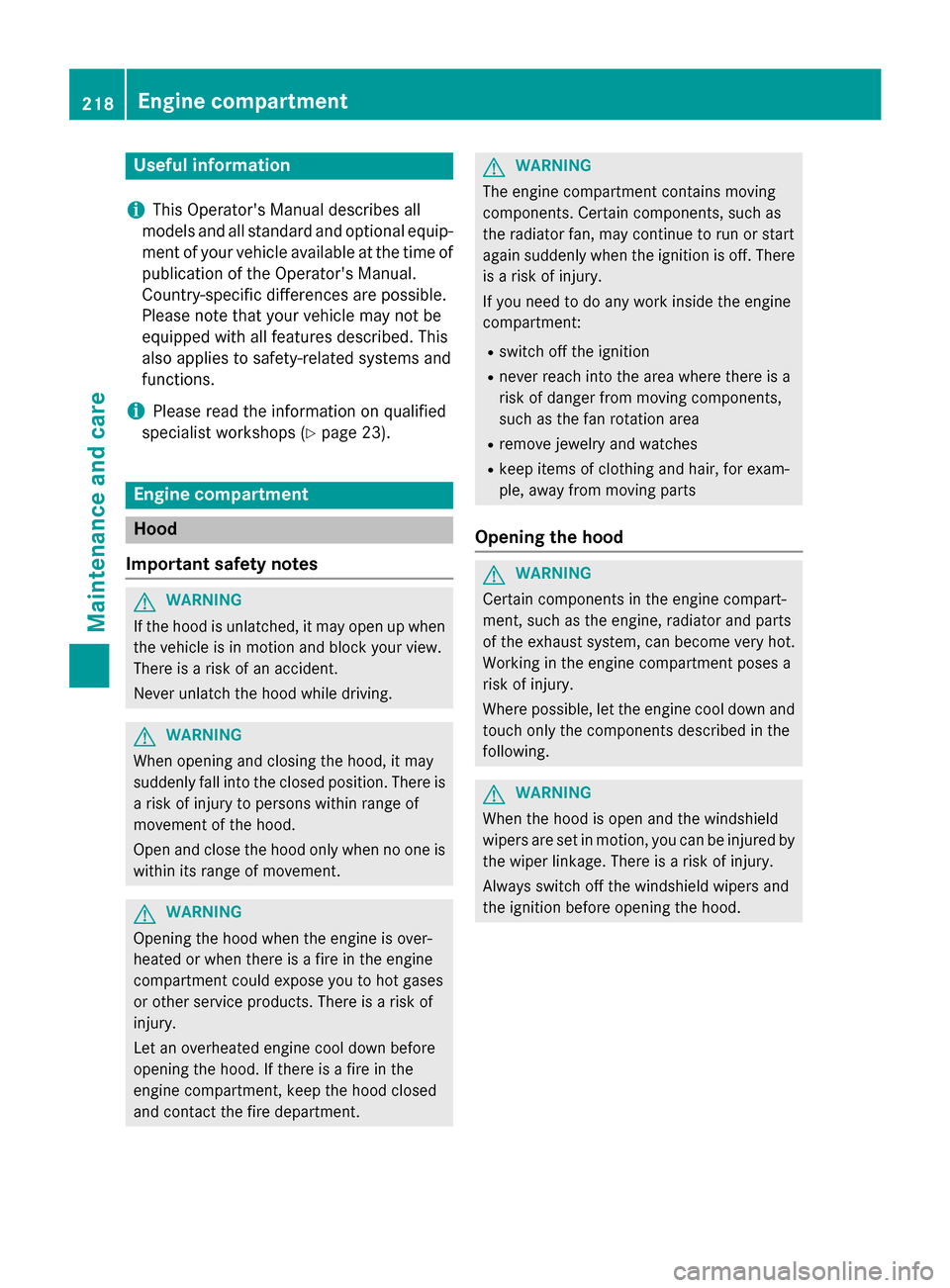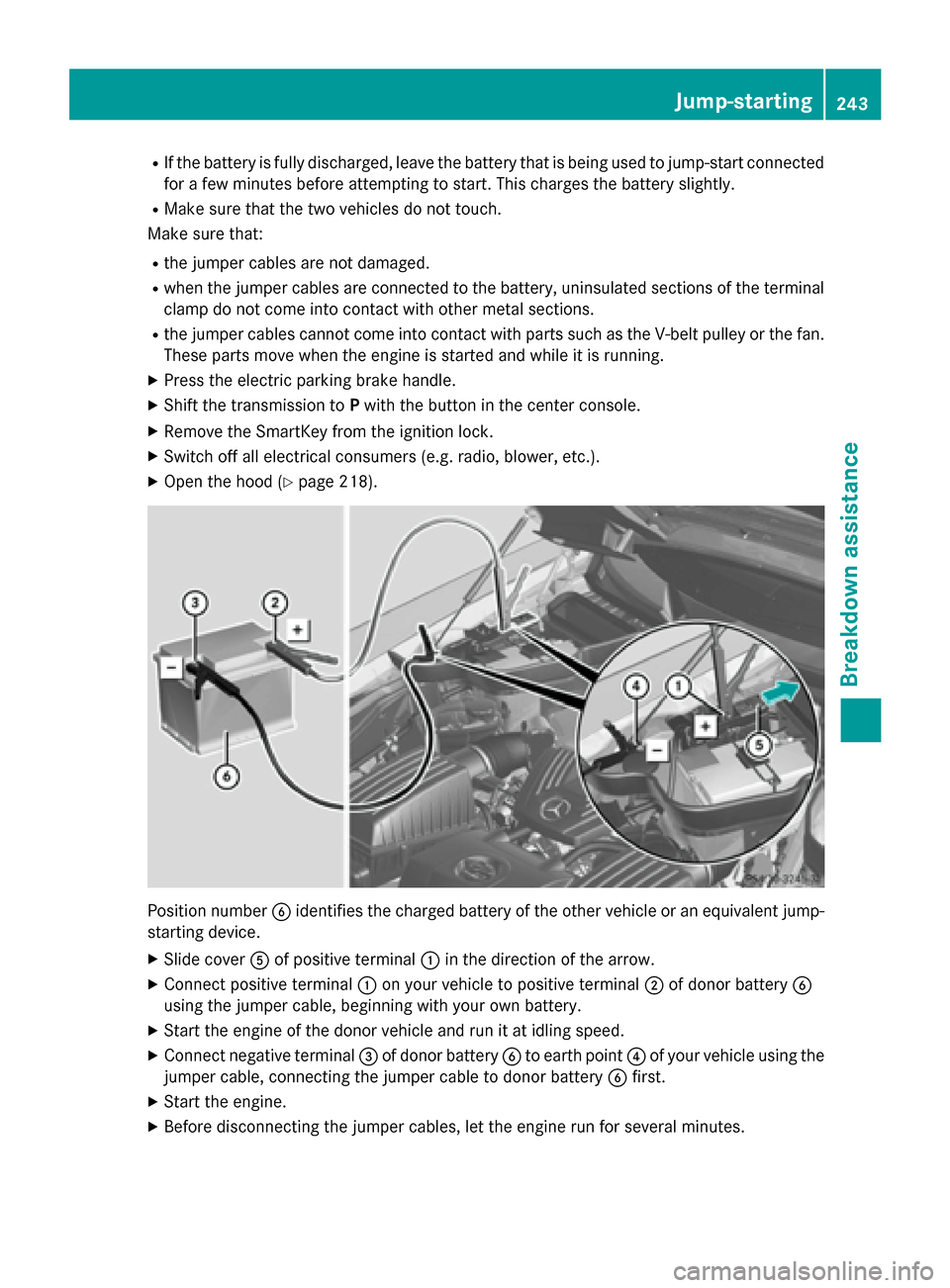Page 220 of 290

Useful information
i This Operator's Manual describes all
models and all standard and optional equip- ment of your vehicle available at the time of
publication of the Operator's Manual.
Country-specific differences are possible.
Please not ethat your vehicle may not be
equipped with all feature sdescribed. This
also applies to safety-related system sand
functions.
i Please read the information on qualified
specialist workshops (Y page 23).Engine compartment
Hood
Important safet ynotes G
WARNING
If the hood is unlatched, it may open up when the vehicle is in motion and block your view.
There is arisk of an accident.
Never unlatc hthe hood while driving. G
WARNING
When openin gand closin gthe hood, it may
suddenly fall int othe closed position .There is
ar isk of injury to person swithin range of
movement of the hood.
Open and close the hood only when no one is
within its range of movement. G
WARNING
Openin gthe hood when the engin eisover-
heated or when ther eisafire in the engine
compartmen tcould expose you to hot gases
or other servic eproducts. There is arisk of
injury.
Let an overheated engin ecool down before
openin gthe hood. If ther eisafire in the
engin ecompartment, keep the hood closed
and contact the fire department. G
WARNING
The engin ecompartmen tcontains moving
components. Certain components, such as
the radiator fan, may continue to run or start
again suddenly when the ignition is off. There is ar isk of injury.
If you need to do any work inside the engine
compartment:
R switc hoff the ignition
R neve rreach int othe area where ther eisa
risk of danger from movin gcomponents,
such as the fan rotation area
R remov ejewelry and watches
R keep items of clothing and hair, for exam-
ple, away from movin gparts
Opening the hood G
WARNING
Certain components in the engin ecompart-
ment ,such as the engine, radiator and parts
of the exhaust system ,can becom every hot.
Working in the engin ecompartmen tposes a
risk of injury.
Where possible, let the engin ecool down and
touc honly the components described in the
following. G
WARNING
When the hood is open and the windshield
wipers are set in motion, you can be injured by the wiper linkage. There is arisk of injury.
Always switc hoff the windshield wipers and
the ignition before openin gthe hood. 218
Engine compartmentMaintenance and care
Page 221 of 290

Hood release leve
rindriver's footwell
X Pull release lever 0043on the hood.
The hood is released.
! Make sure that the windshield wipers are
not folded away from the windshield .You
coul dotherwise damag ethe windshield
wipers or the hood. X
Reach into the gap ,pullh ood catch han-
dle 0044up and lift the hood.
Closing the hood X
Lower the hood and let it fal lfrom aheight
of approximatel y8inches (20 cm).
X Check that the hood has engaged properly.
If the hood can be raised slightly ,itisnot
properl yengaged .Openita gain and close
it with alittle more force. Engine oil
General notes Depending on the driving style, the vehicle
consumes up to 0.9 US qt (0.8 l) of oil over a
distance of 600 miles (1000 km). The oil con- sumptio nmay be higher than this whe nthe
vehicle is new or if yo ufrequently drive at high
engine speeds.
Depending on the engine, the oil dipstick may
be in adifferent location.
Whe nchecking the oil level:
R park the vehicle on aleve lsurface.
R the engine should be switched off for
approximatel yfive minutes if the engine is
at normal operating temperature.
R if the engine is not at normal operating
temperature, e.g. if the engine wa sonly
started briefly ,waita bout 30 minutes
before carrying out the measurement.
Checking the oill evel usin gthe oild ip-
stick G
WARNING
Certai ncomponents in the engine compart-
ment, such as the engine, radiator and parts
of the exhaust system, can become very hot.
Working in the engine compartment pose sa
risk of injury.
Where possible, let the engine cool dow nand
touch only the components describe dinthe
following. Engine compartment
219Maintenance and care Z
Page 245 of 290

R
If the battery is fullyd ischarged, leave the battery that is being used to jump-start connected
for afew minutes before attempting to start. This charges the battery slightly.
R Make sure that the two vehicle sdonot touch.
Make sure that:
R the jumper cablesa re not damaged.
R when the jumper cablesa re connected to the battery, uninsulated sections of the terminal
clamp do not come into contact with other metal sections.
R the jumper cablesc annot come into contact with parts such as the V-belt pulley or the fan.
These parts move when the engine is started and whileitisr unning.
X Press the electric parking brake handle.
X Shift the transmission to Pwith the button in the center console.
X Remove the SmartKey from the ignition lock.
X Switch off all electrical consumers (e.g. radio, blower, etc.).
X Open the hood (Y page 218). Positio
nnumber 0084identifie sthe charged battery of the other vehicle or an equivalent jump-
starting device.
X Slide cover 0083of positive terminal 0043in the direction of the arrow.
X Connect positive terminal 0043on yourv ehicle to positive terminal 0044of donor battery 0084
using the jumper cable,b eginning with yourown battery.
X Start the engine of the donor vehicle and run it at idling speed.
X Connect negative terminal 0087of donor battery 0084to earth point 0085of yourv ehicle using the
jumper cable,c onnecting the jumper cable to donor battery 0084first.
X Start the engine.
X Before disconnecting the jumper cables, let the engine run for several minutes. Jump-starting
243Breakdown assistance Z